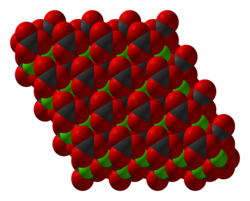Cobalt(II) carbonate Last updated April 26, 2025 Cobalt(II) carbonate Co2+ CO3 2−
Cobalt(II) carbonate powder Names IUPAC name Cobalt(II) carbonate
Other names Cobaltous carbonate; cobalt(II) salt
Identifiers ChemSpider ECHA InfoCard 100.007.428 UNII InChI=1S/CH2O3.Co/c2-1(3)4;/h(H2,2,3,4);/q;+2/p-2
N Key:
ZOTKGJBKKKVBJZ-UHFFFAOYSA-L
N InChI=1/CH2O3.Co/c2-1(3)4;/h(H2,2,3,4);/q;+2/p-2
Key: ZOTKGJBKKKVBJZ-NUQVWONBAB
Properties CoCO3 Molar mass 118.941 g/mol Appearance pink solid Density 4.13 g/cm3 Melting point 427 °C (801 °F; 700 K) [ 1] cobalt(II) oxide (anhydrous) °C (284 °F; 413 K) 0.000142 g/100 mL (20 °C) [ 2] 1.0·10−10 [ 3] Solubility soluble in acid alcohol , methyl acetate ethanol 1.855 Structure Rhombohedral (anhydrous) Thermochemistry 79.9 J/mol·K [ 1] −722.6 kJ/mol [ 1] −651 kJ/mol [ 1] Hazards GHS labelling [ 4] Warning H302 , H315 , H317 , H319 , H335 , H351 [ 4] P261 , P280 , P305+P351+P338 [ 4] NFPA 704 diamond) Lethal dose or concentration (LD, LC):640 mg/kg (oral, rats) Except where otherwise noted, data are given for materials in their
standard state (at 25
°C [77
°F], 100
kPa).
Chemical compound
Cobalt(II) carbonate is the inorganic compound with the formula CoCO3 . This pink paramagnetic solid is an intermediate in the hydrometallurgical purification of cobalt from its ores. It is an inorganic pigment, and a precursor to catalysts . [ 5] Cobalt(II) carbonate also occurs as the rare red/pink mineral spherocobaltite . [ 6]
Preparation and structure Structure of solid cobalt(II) carbonate shown with space-filling ions. Color code: red = O, green = Co, blck = C It is prepared by combining solutions of cobalt(II) sulfate and sodium bicarbonate :
CoSO4 + 2 NaHCO3 → CoCO3 + Na2 SO4 + H2 O + CO2 This reaction is used in the precipitation of cobalt from an extract of its roasted ores. [ 5]
CoCO3 adopts a structure like calcite , consisting of cobalt in an octahedral coordination geometry . [ 7]
Reactions Like most transition metal carbonates, cobalt carbonate is insoluble in water, but is readily attacked by mineral acids:
CoCO3 + 2 HCl + 5 H2 O → [Co(H2 O)6 ]Cl2 + CO2 It is used to prepare many coordination complexes. The reaction of cobalt(II) carbonate and acetylacetone in the presence of hydrogen peroxide gives tris(acetylacetonato)cobalt(III) . [ 8]
Heating the carbonate proceeds in a typical way for calcining , except that the product becomes partially oxidized:
6 3 + O2 → 2 3 O4 + 6 2 The resulting Co3 O4 converts reversibly to CoO at high temperatures. [ 9]
Safety Toxicity has rarely been observed. Animals, including humans, require trace amounts of cobalt, a component of vitamin B12 . [ 5]
References 1 2 3 4 "Cobalt(II) carbonate" . ↑ Haynes, W.M., ed. (2017). CRC Handbook of Chemistry and Physics (97th ed.). CRC Press, Taylor & Francis Group. pp. 4– 58. ISBN 978-1-4987-5429-3 ↑ "Solubility product constants" . Archived from the original on 2012-06-15. Retrieved 2012-05-17 . 1 2 3 Sigma-Aldrich Co. , Cobalt(II) carbonate . Retrieved on 2014-05-06. 1 2 3 Donaldson, John Dallas; Beyersmann, Detmar (2005). "Cobalt and Cobalt Compounds". Ullmann's Encyclopedia of Industrial Chemistry . Weinheim: Wiley-VCH. doi :10.1002/14356007.a07_281.pub2 . ISBN 3527306730 1 2 "Spherocobaltite: Spherocobaltite mineral information and data" . www.mindat.org . Retrieved 7 August 2018 . ↑ Pertlik, F. (1986). "Structures of hydrothermally synthesized cobalt(II) carbonate and nickel(II) carbonate". Acta Crystallographica Section C . 42 : 4– 5. doi :10.1107/S0108270186097524 . ↑ Bryant, Burl E.; Fernelius, W. Conard (1957). "Cobalt(III) Acetylacetonate". Inorganic Syntheses . pp. 188– 189. doi :10.1002/9780470132364.ch53 . ISBN 9780470132364 ↑ El-Shobaky, G. A.; Ahmad, A. S.; Al-Noaim, A. N.; El-Shobaky, H. G. (1996). "Thermal Decomposition of Basic Cobalt and Copper Carbonates". Journal of Thermal Analysis and Calorimetry . 46 : 1801. doi :10.1007/BF01980784 . ↑ Bhojane, Prateek; Le Bail, Armel; Shirage, Parasharam M. (2019). "A Quarter of a Century After its Synthesis and with >200 Papers Based on its Use, 'Co(CO3 )0.5 (OH)0.11 H2 O′ Proves to be Co6 (CO3 )2 (OH)8 ·H2 O from Synchrotron Powder Diffraction Data" . Acta Crystallographica Section C: Structural Chemistry . 75 (Pt 1): 61– 64. doi :10.1107/S2053229618017734 . PMID 30601132 . S2CID 58657483 . External links
H2 CO3 He Li2 CO3 ,LiHCO3 BeCO3 +BO3 (RO)(R'O)CO +C2 O4 (NH4 )2 CO3 ,NH4 HCO3 ,+NO3 O +F Ne Na2 CO3 ,NaHCO3 ,Na3 H(CO3 )2 MgCO3 ,Mg(HCO3 )2 Al2 (CO3 )3 SiCO4 ,+SiO4 P +SO4 +Cl Ar K2 CO3 ,KHCO3 CaCO3 ,Ca(HCO3 )2 Sc Ti V CrCO3 ,Cr2 (CO3 )3 MnCO3 FeCO3 CoCO3 ,Co2 (CO3 )3 NiCO3 Cu2 CO3 ,CuCO3 , Cu2 CO3 (OH)2 ZnCO3 Ga Ge As Se Br Kr Rb2 CO3 SrCO3 Y Zr Nb Mo Tc Ru Rh PdCO3 Ag2 CO3 CdCO3 In Sn Sb Te I Xe Cs2 CO3 ,CsHCO3 BaCO3 * Lu2 (CO3 )3 Hf Ta W Re Os Ir Pt Au HgCO3 Tl2 CO3 PbCO3 (BiO)2 CO3 Po(CO3 )2 At Rn Fr RaCO3 ** Lr Rf Db Sg Bh Hs Mt Ds Rg Cn Nh Fl Mc Lv Ts Og * La2 (CO3 )3 Ce2 (CO3 )3 Pr2 (CO3 )3 Nd2 (CO3 )3 Pm Sm2 (CO3 )3 EuCO3 ,Eu2 (CO3 )3 Gd2 (CO3 )3 Tb2 (CO3 )3 Dy2 (CO3 )3 Ho2 (CO3 )3 Er2 (CO3 )3 Tm2 (CO3 )3 Yb2 (CO3 )3 ** Ac Th(CO3 )2 Pa UO2 CO3 Np Pu Am Cm Bk Cf Es Fm Md No
Cobalt(I) Cobalt(II) Cobalt(0,III) Cobalt(II,III) Cobalt(III) Cobalt(III,IV) Cobalt(IV) Cobalt(V)
This page is based on this
Wikipedia article Text is available under the
CC BY-SA 4.0 license; additional terms may apply.
Images, videos and audio are available under their respective licenses.


 [4]
[4] 
